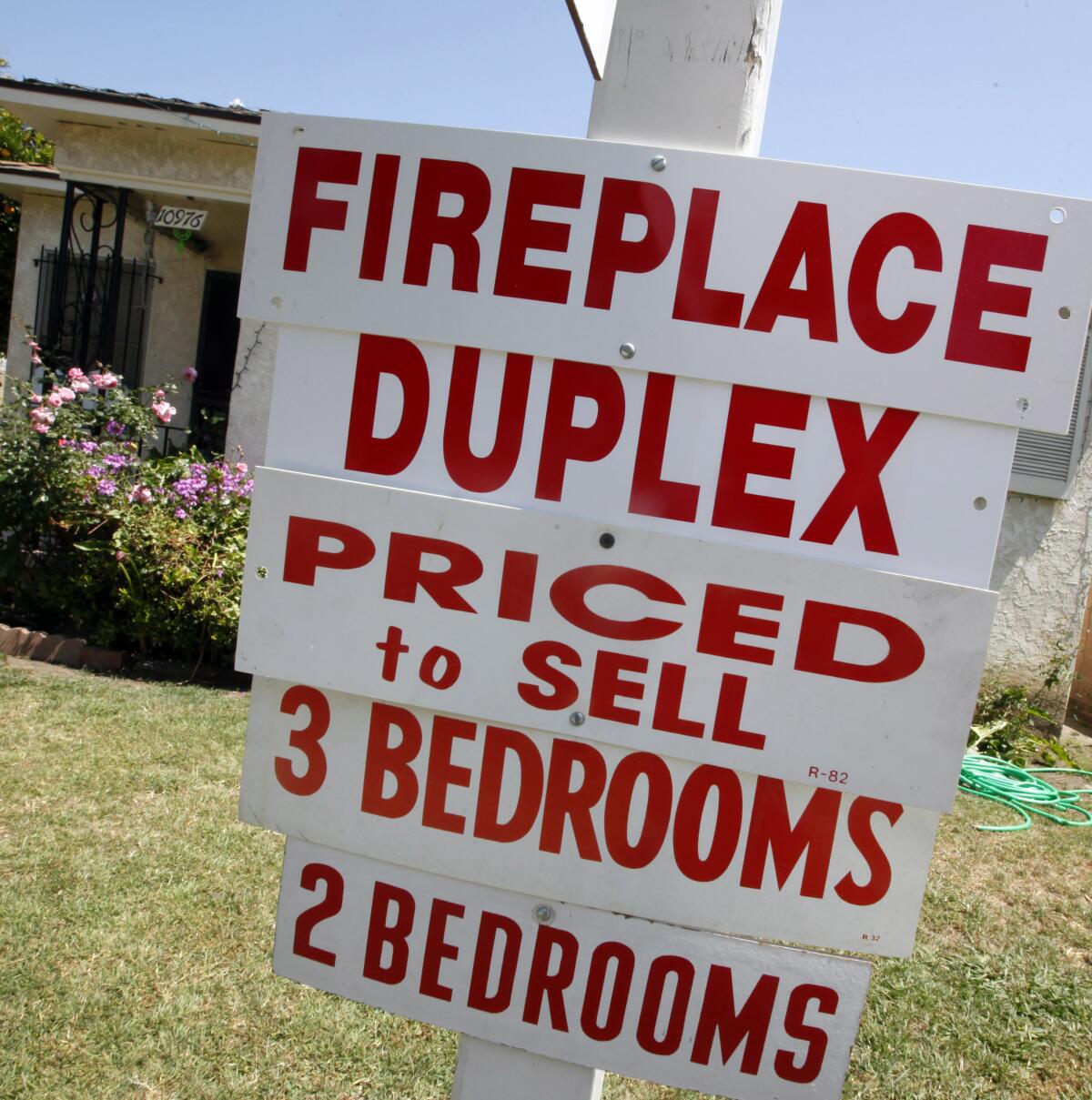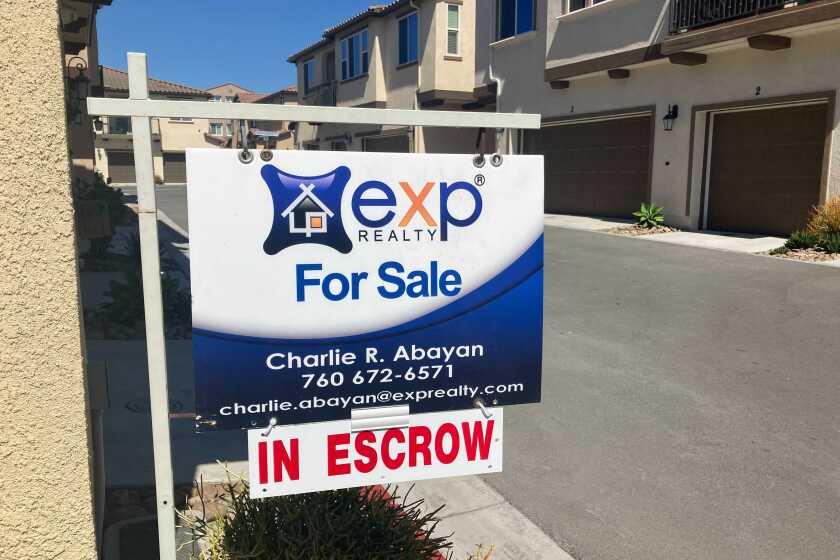California offers affordable loans again to first-time home buyers, with a catch

- Share via
When the California Housing Finance Agency offered no-interest, no-monthly-payment loans in the spring to help lower-income residents come up with a down-payment and fees to buy their first home, the entire budget of nearly $300 million was gobbled up in only 11 days.
Lawmakers then steered an additional $225 million into the program during the state budget negotiations last year, and CalHFA is aiming to award those funds this spring. But there won’t be a mad dash for cash this time — instead of handing out the loans on a first-come, first-served basis, the state will choose qualified applicants by lottery.
The program has also tightened its requirements, requiring applicants not just to be non-homeowners, but also to have parents who are not currently homeowners. The point is to focus the program more tightly on Californians most in need of the state’s help.
About 2,100 of the loans were granted before the money ran out in April, said Eric Johnson, a CalHFA spokesperson. Since then, home sales have cooled in California as interest rates climbed above 7%.
Limited to covering the down payment and closing costs on a first home, the California Dream for All Shared Appreciation Loans max out at $150,000 or 20% of the home’s purchase price, whichever is smaller. They’re treated as second mortgages, but require no payments of any kind until the home is refinanced, resold or its first mortgage is paid off, at which point the state loan must be repaid in full.
What makes the loans unusual — and attractive — is that they don’t accrue interest. Instead, their value rises over time with the value of the home. When a Dream for All loan comes due, the borrower repays the principle plus a percentage of the increase in the home’s value that matches the percentage of the purchase price covered by the loan. If the home doesn’t increase in value, nothing is added to the Dream for All loan.
For example, if the Dream for All loan covered 18% of the purchase price and the borrower sells the home for $100,000 more than they paid for it, the borrower would have to repay the Dream for All loan plus 18% of $100,000, or $18,000. Borrowers with incomes of 80% or less of the county’s median income get an additional break, paying a smaller percentage of the increase in value.
Aspiring homeowners can’t apply for the loans just yet, but they can work with participating lenders on the paperwork required to obtain one. The program will start accepting applications online in April, Johnson said.
California’s state budget is restoring two assistance programs for first-time home buyers and ADU builders. Here’s what you need to know.
Who can obtain a Dream for All loan?
To meet the definition of a first-time, first-generation homeowner, the borrower must not have held a stake in a house in the United States in the last seven years. Also, their parents may not currently hold a stake in a home. If the parents are deceased, they may not have owned a home at the time of their death. The program is also open to any Californian “who has at any time been placed in foster care or institutional care,” CalHFA says in the program manual.
If there is more than one buyer involved, at least one must be a current California resident, and at least one must be a first-generation home buyer. Borrowers must also be U.S. citizens or noncitizens authorized to be in the country, and they must make the home they buy their main residence within 60 days after purchasing it.
The annual income limit for qualified borrowers is 120% of the area median income, which varies from county to county. For example, it’s $155,000 for borrowers in Los Angeles County, $202,000 in Orange County and $195,000 in Ventura County.
How do you apply?
The first step, Johnson said, is to work with a lender that’s participating in the program to obtain a prequalification letter. The lender’s role is to make sure that you’re qualified for the Dream for All program, not necessarily for a loan. Yet before issuing a letter, the lender will check your credit report and debt-to-income ratio to determine how large of a loan you could potentially afford, so your financial health will be a factor.
You can find a list of lenders participating in the Dream for All program at the CalHFA website.
The state will open an online portal in the first week of April for applicants to submit their prequalification letters, Johnson said. One reason to give the public a few months to prepare before applications can be filed, he said, was to allow people time to improve their credit scores or take other steps needed to obtain a prequalification letter.
How will applicants be chosen?
CalHFA will accept prequalification letters for about a month, Johnson said, and they’ll all be treated equally regardless of when they arrive during that period. After reviewing the letters to make sure the applicants are qualified, the agency will hold a lottery to select which borrowers will receive vouchers for the Dream for All loans.
The total budget for the program is enough for about 1,670 loans of $150,000. Johnson said many borrowers will take out smaller amounts, so the program expects to support 1,700 and 2,000 loans.
What happens after you receive a voucher?
Getting approved for a Dream for All loan doesn’t mean that you’ll be able to buy a house. You’ll still have to find one for sale that you can afford, persuade the owner to choose your bid, and then qualify for the mortgage loan from a bank, credit union or other lender.
With a voucher in hand, however, you’ll be able to make a substantial down payment, which translates to lower monthly mortgage payments.
More to Read
Sign up for Essential California
The most important California stories and recommendations in your inbox every morning.
You may occasionally receive promotional content from the Los Angeles Times.







![Vista, California-Apri 2, 2025-Hours after undergoing dental surgery a 9-year-old girl was found unresponsive in her home, officials are investigating what caused her death. On March 18, Silvanna Moreno was placed under anesthesia for a dental surgery at Dreamtime Dentistry, a dental facility that "strive[s] to be the premier office for sedation dentistry in Vitsa, CA. (Google Maps)](https://ca-times.brightspotcdn.com/dims4/default/07a58b2/2147483647/strip/true/crop/2016x1344+29+0/resize/840x560!/quality/75/?url=https%3A%2F%2Fcalifornia-times-brightspot.s3.amazonaws.com%2F78%2Ffd%2F9bbf9b62489fa209f9c67df2e472%2Fla-me-dreamtime-dentist-01.jpg)







